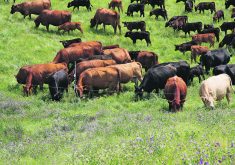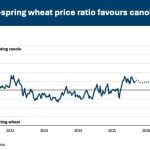Acupuncture on animals
I am prompted to write this after reading Dr. Jeff Grognet’s column on acupuncture, which appeared in the March 18 edition. The article is misleading and creates an improper image of the state of this alternative therapy in veterinary medicine.
He states that acupuncture has been used in animals for thousands of years. The fact is, it has only been used in animals during the past century and is primarily a North American phenomenon. The ancient Chinese thought animals did not possess the “qi” necessary for it to work.
Read Also

Farmers urged to be grain-safe this fall
Working around grain bins comes with risk, from farmers falling to drowning in grain: Experts have five tips to help avoid grain-related accidents this harvest.
The “energy channels called meridians” he refers to exist only in the imagination of acupuncture practitioners. There is no credible evidence that acupuncture works at all.
Veterinarians are expected to embrace the wisdom of evidence based medicine. Sadly some veterinarians are ignoring this and offering alternative therapies like acupuncture.
Kenn Wood, DVM
Ebenezer, Sask.
Tommy Douglas files
The Canadian Security Intelligence Service must release Tommy Douglas’s files.
This time we all need to look beyond partisan politics. Here was a man who made a profound difference as to how Canadians have come to live their daily lives without the worry of bankruptcy if they should fall ill.
As the recognized quarterback for medicare, Tommy Douglas put the squeeze on the government of Lester Pearson and Medicare became a reality for all Canadians.
Saskatchewan has a very colourful history when it comes to politics. Tommy Douglas brought the first socialist government to North America. Although I opposed his political philosophy, I have a deep respect for the man, his opinions and his convictions.
Tommy Douglas belongs to Saskatchewan and its historical past. Every shred of documentation being held by CSIS must be turned over immediately to the citizens of Saskatchewan to be read, studied and to learn from our past.
The Brad Wall government of Saskatchewan must support this initiative fully. Those Saskatchewan citizens who followed Tommy Douglas and his thinking have the right to study their former leader’s political life. The rest of us also have the right to examine the history of this man.
Stew Fettes,
Regina, Sask.
Market, not buy
In his March 11 letter to the editor regarding the CWB (“Gov’t control of CWB”), Douglas McBain made two statements that are incorrect. He stated that after 1943, “all wheat from that day on would be bought exclusively by the CWB with the price set by the federal cabinet.”
First, the Canadian Wheat Board does not buy wheat. It markets wheat to countries that are the buyers and returns all the proceeds to producers other than the costs to operate the board.
Second, the cabinet is not involved in setting the grain price. The board is able to sell to different countries at varying prices. What the cabinet does is set an upper limit on the value that can be issued to producers at the time of delivery.
Since the federal government would be on the hook for any deficit should prices drop dramatically during the year, this is a precautionary measure to protect the taxpayers’ interest.
Don Scott,
Garrick, Sask.
Imperfect scenario
In response to Douglas McBain’s letter (Open forum, March 11,) Mr. McBain states that the CWB was not created to address any defects in the market, but the farmer owned and operated pools were created to give farmers control in the grain market and as stated was taken over during the war to safeguard food supply by the government, hence the CWB.
In the beginning the wheat pools were created for and by farmers to protect themselves from multinational and foreign companies coming in and harvesting large profits off the backs of the producers.
Today you only have to look at the farmer level feedlots and pork producers to see what I mean, if you can find one.
If producers think we are gaining control by getting rid of the CWB, I’m afraid it is going to be the opposite by losing control to the large multinationals. You talk of choice, but really what are going to be these new choices? The same choices that are in the cattle and hog sectors? I wouldn’t say that is a perfect scenario.
The CWB is by far not the same CWB that took over in 1943. I would wonder how many naysayers have taken a trip to Winnipeg and seen the dedicated, talented, educated young people and the facilities that have been offered to us to market , in many cases niche market, our wheat worldwide, at only 10 to 12 cents per bushel.
I believe if you crop 30 to 50 percent of your farm to wheat, it makes a bigger difference than if wheat was only a small part or non-existent in your rotation.
Gerald Marshman,
Rockyford, Alta.
Disease reporting
Re: “Delayed reporting causes concern in latest BSE case,” (WP, March 18.) The government of Canada is committed to safe food and healthy animals. That’s why we take our responsibilities regarding BSE very seriously.
This recent case should not affect exports of Canadian cattle or beef as Canada is recognized by the World Organization for Animal Health for its stringent surveillance program and controlled risk status.
Canada is very open and transparent about its national BSE surveillance program and the ongoing detection of a limited number of cases.
The Canadian Food Inspection Agency respects all international disease reporting obligations.
In fact, all confirmed cases of federally reportable diseases, including BSE, are posted monthly on our website. We also work with industry to inform all implicated sectors of relevant disease developments.
In addition, the CFIA immediately announces detections of animal diseases posing significant health or economic risks.
Canada has built a reputation as a world renowned supplier of quality beef. Together with producers, our partners and our stakeholders, we are working to provide safe, high-quality beef products at home and abroad.
Dr. Francine Lord,
Deputy Chief Veterinary Officer of Canada,
Canadian Food Inspection Agency,
Ottawa, Ont.
About carbon
Allow me to address the points made by Mr. Lysne, (Open Forum Feb. 18) and Mr. Jackson (Open Forum, March 4), regarding my letters to your newspaper Feb. 4, (“Credentials offered”) and Dec. 10, (“Protecting climate: our responsibility”) respectively.
My point about the loss of carbon from the breaking of the virgin prairie soil had to do with the carbon stored in the humic fraction of the soil.
Any good soils textbook will tell the reader that soil organic carbon stored in the humic fraction has been removed from the fast carbon cycle that Mr. Lysne refers to in his letter.
This carbon is basically sequestered in the soil and is not available for exchange with the atmosphere.
My point in the Feb. 4 letter was that breaking prairie soils for agriculture causes a significant portion of this ancient sequestered carbon to be liberated from the soil. The carbon is liberated by the process of bacterial decomposition, as the bacteria are stimulated by aeration of the soil, and other changes, caused by plowing.
Agricultural soil scientists have been very concerned about this loss of carbon because of its negative effects on soil structure and fertility. It is to be hoped that zero-till systems will remedy some of this problem and help in the rebuilding of soil organic matter in the coming years.
Meanwhile, it is not relevant how much carbon our crops fix because we then eat the crops, or our domesticated animals eat them, and the carbon is liberated back into the atmosphere as CO2 or methane.
So the net effect of growing and then eating a crop is exactly zero with regard to atmospheric carbon except that a huge amount of CO2 is liberated by the machines working the fields and is consumed and liberated to the atmosphere in the production of agricultural chemicals.
The point about native prairie is that it was, and still is, a net sequesterer of atmospheric carbon, whereas cropland is a net liberator of sequestered carbon into the atmosphere.
Relative to this question of sequestration, Mr. Lysne’s math work about carbon cycles and crops is simply not to the point…
Concerning Mr. Jackson’s comments, the Oregon Petition that he refers to has been debunked as a fraudulent attempt by climate deniers to contest the overwhelming consensus that climate change is real and that we are probably contributing to that change by carrying out activities that release fossil fuel carbon and soil carbon into the atmosphere. …
It seems a little paranoid to talk about the International Panel on Climate Change as a “tentacle” of the United Nations.
Scientists and concerned individuals from all over the planet are trying to come together to face the very significant challenge that our release of fossil carbon is posing for the world’s ecosystems.
His argument that the UN is responsible to no one is preposterous. We have our representatives at the UN and they report to the government of Canada. That seems responsible enough. The scientific argument for the greenhouse model of climate change has been debated and examined very thoroughly. …
The flowering dates of prairie plants in Western Canada are now, on average, one to two weeks earlier than they were 20 or 30 years ago.
These are physical evidence that the climate is warming. I don’t doubt there may be other causes for this warming besides our release of fossil fuel carbon into the atmosphere, but there is little value to be gained in denying the physical evidence of warming.
It is our responsibility to our children and all those yet to come, to face this challenge squarely and to do our best to avert the worst of its effects…
Robert A. Wright, Ph.D.,
Regina, Sask.
Desired answer
Re: Western Producer, March 11, “Ritz takes aim at CWB monopoly.” I see that Mr. Ritz and the Conservatives are still spinning from every angle. (Ritz) talks about a plebiscite three years ago. I would say it’s close to four years, but who’s counting?
The plebiscite had three options: one option favoured single desk selling of barley. The other two options were anti-single desk selling.
If each option were dealt with separately, single desk selling was the winning option.
The government – Mr. Ritz and Chuck Strahl, his predecessor – wanted the anti-CWB outcome on this plebiscite. How they got the answer they wanted (was) they added the two anti-wheat board options together and bingo, they got the answer they wanted and are still spinning a yarn about the plebiscite.
What’s that saying? Figures don’t lie but liars figure.
It’s my wish that journalists would start questioning government officials when they make statements that are misleading and half-truths.
David Bailey,
Saskatoon, Sask.














